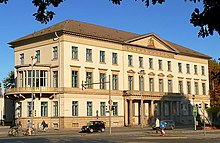Wangenheim Palace
The Wangenheimpalais is a building in the Mitte district of Hanover . From 1863 to 1913 it was the town hall and seat of the city administration of Hanover. Today it is the seat of the Lower Saxony Ministry of Economics .
history
The Wangenheim Palace was built in the years 1829–1832 according to plans by the Hanoverian court architect Georg Ludwig Friedrich Laves . Georg Moller probably had an advisory role here . Georg Christian von Wangenheim placed the order for the construction . The building was also supplemented by a winter garden by Laves in 1844 .
The ruler George V ascended the throne in 1851. As a result, the crown donation acquired the building and made it the Residenz-Palais . Georg lived here for a period of ten years.
In 1862, the acquired magistrate of the city of Hanover, the building and set up for a refurbishment by Ludwig Droste here the "new" town hall. It served this purpose until 1913. Then the town hall moved into the newly created New Town Hall diagonally opposite.
During the Second World War , the Wangenheim Palace was destroyed in one of the air raids on Hanover in 1943. It burned down, but was rebuilt a few years later and used for urban purposes. After it was demolished for the route along the Leibnizufers, the Brückmühle's coat of arms was placed in the gable of the facade of the Wangenheim Palace.
The Lower Saxony Ministry of Economics was located here from 1957 onwards . From 1994 to 2013 there was a bus stop opposite the Wangenheimpalais, which was designed in the shape of a sailboat by the Italian designer Massimo Iosa Ghini and which is part of the BUSSTOPS art project . This was moved in 2013 to the opposite side of the street in front of the August Kestner Museum .
Wangenheimpalais at night with the bus stop for the art project BUSSTOPS
Illumination in spring, seen from the banks of the Leine at the Leineschloss
Web links
- Description of the Wangenheim-Palais at the Lower Saxony Ministry of Economics, Labor and Transport
- Description of building and coat of arms
- Brief description at hannover.de
Coordinates: 52 ° 22 ′ 9 ″ N , 9 ° 44 ′ 5 ″ E




